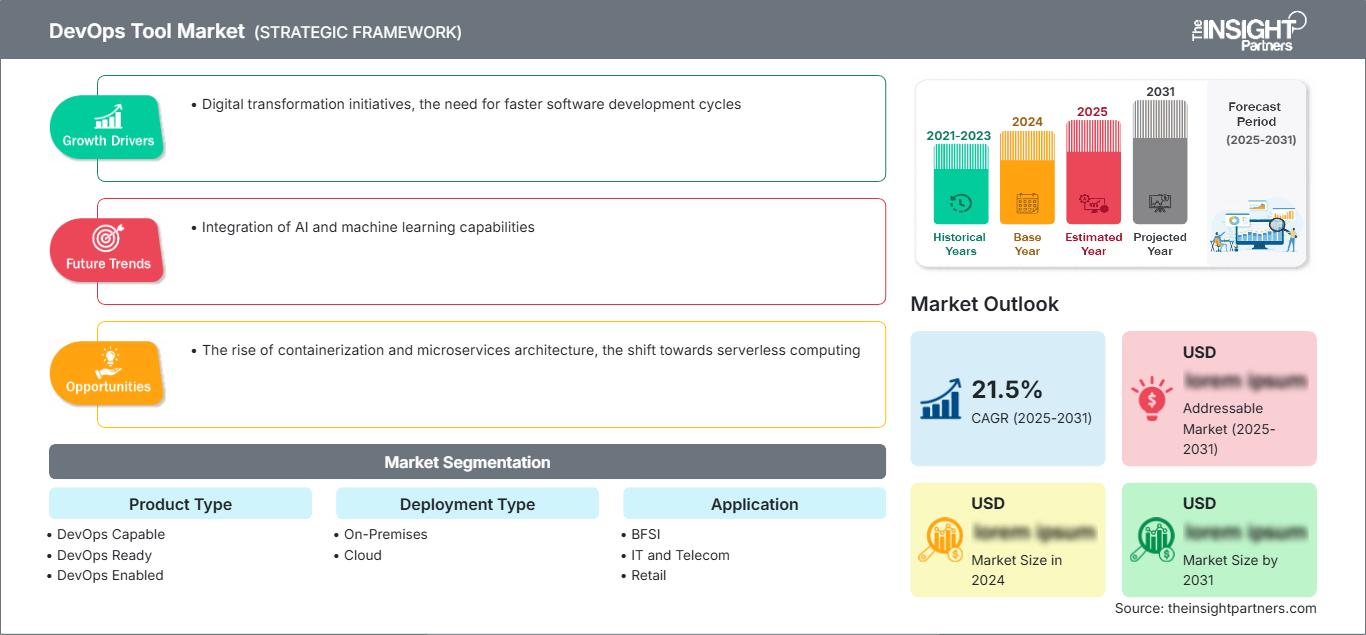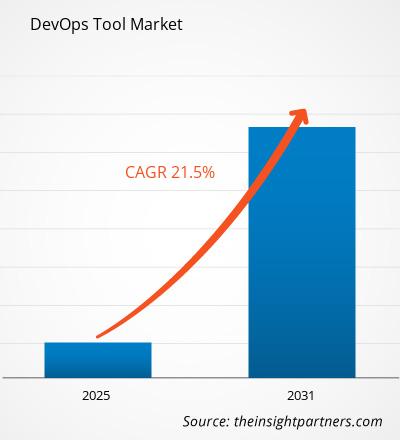DevOpsツール市場は、2023~2031年の間に21.5%のCAGRを記録すると予想されています。コンテナ化とマイクロサービスアーキテクチャの台頭、そしてサーバーレスコンピューティングへの移行は、引き続き市場の主要なトレンドとなるでしょう。
DevOpsツール市場分析
- DevOpsツールはソフトウェア開発とデプロイメントを加速するように設計されているため、採用が増加しており、あらゆる分野のリーダー企業がDevOpsツールに多額の投資を行っています。
- 大企業は明らかにリーダーであり、多くがすでにエンドツーエンドのDevOpsツールチェーンを展開しています。
- 中規模企業も急速に追いついています。主要なツールは、バージョン管理システムからCI/CD(継続的インテグレーション/継続的デプロイメント)プラットフォーム、コンテナ化テクノロジー、監視ツールまで多岐にわたります。
- クラウドコンピューティングの幅広いトレンドが続く中、クラウドネイティブのDevOpsツールも普及しつつあります。導入状況は様々で、DevOps にまだ慣れていない組織や、文化の変革や統合の面で遅れをとっている組織もあります。
DevOps ツール市場の概要
- DevOps 市場は、企業変革と、ソフトウェアを迅速かつ容易に提供する必要性に伴う技術の絶え間ない進化という課題への対応を目的としたデジタル化イニシアチブの増加により、力強い成長を遂げています。
- 自動化、コラボレーション、継続的インテグレーション/デリバリーのためのツールとプラットフォームのスイートにまたがり、多くの大手テクノロジー企業やスタートアップ企業がこの分野に参入しています。北米は導入をリードしていますが、アジア太平洋地域も急速に成長しています。クラウド プラットフォームの需要は高まっています。市場では、DevOps 導入時のスキルギャップや組織内の抵抗に関する課題が見られてきましたが、この変革は大きな成果をもたらすでしょう。
要件に合わせてレポートをカスタマイズ
レポートの一部、国レベルの分析、Excelデータパックなどを含め、スタートアップ&大学向けに特別オファーや割引もご利用いただけます(無償)
DevOpsツール市場: 戦略的洞察

- このレポートの主要な市場動向を入手してください。この無料サンプルには、市場動向から見積もりや予測に至るまでのデータ分析が含まれます。
レポートの一部、国レベルの分析、Excelデータパックなどを含め、スタートアップ&大学向けに特別オファーや割引もご利用いただけます(無償)
DevOpsツール市場: 戦略的洞察

- このレポートの主要な市場動向を入手してください。この無料サンプルには、市場動向から見積もりや予測に至るまでのデータ分析が含まれます。
DevOps ツール市場の推進要因と機会
市場に有利なソフトウェア開発サイクルの高速化の必要性
- DevOps ツール市場の主要な推進要因の 1 つは、デジタル システムが急速に変化している環境において、ソフトウェア開発ライフサイクルの高速化が求められていることです。これらの重要なシステムは、競争力を高め、顧客の需要とテクノロジーによって可能になる新しい可能性に対応できる新しいサービスと製品を市場に投入することを目的としています。
- このスピード需要は、変化する市場、顧客、技術要件に迅速に対応したいという要望から生じており、DevOps ツールはソフトウェア開発ライフサイクルの一部を自動化し、いわゆる継続的インテグレーションと継続的デリバリー (CI/CD) を促進することでソフトウェア開発を加速できます。
- DevOps ツールは、自動化、簡素化、プロセスの最適化、手作業によるエラーの削減を通じて、組織がソフトウェア開発とより安定したソフトウェア システムの導入を迅速化できるようにし、ビジネスの俊敏性を高め、反復を迅速化し、製品とサービスを市場に早く投入し、競争力を高めて、売上とビジネスの拡大を促進します。したがって、より迅速なソフトウェア開発ライフサイクルの需要は、DevOps ツール市場の成長と革新に貢献します。
AI と機械学習機能の統合
- AI と機械学習機能の統合により、DevOps ツールプロバイダーは、これらのテクノロジーに組み込まれている自動化、意思決定、予測機能を活用できるようになります。
- AI と ML 機能を組み込んだツールは、多くの複雑なタスクを自動化し、システム障害を予測し、リソース使用率を特定して最大化し、セキュリティガードレールの品質と有効性を向上させ、次に何をすべきかについてのインテリジェントなアラートと洞察を提供することができます。
- DevOps ツールは、予測メンテナンス、よりスマートなテスト、より優れたキャパシティプランニングなど、より高度な機能を提供できます。このような統合により、DevOps プロセスの効率と有効性が向上するだけでなく、差別化によってベンダーが数多くの代替ツール プロバイダーから目立つようになります。
DevOps ツール市場レポートのセグメンテーション分析
DevOps ツール市場分析の導出に貢献した主要なセグメントは、製品タイプ、展開タイプ、およびアプリケーションです。
- 製品タイプに基づいて、DevOps ツール市場は、DevOps 対応、DevOps 準備完了、および DevOps 対応に分かれています。
- 展開タイプに基づいて、DevOps ツール市場はオンプレミスとクラウドに分かれています。 BFSI、IT および通信、小売、その他
- アプリケーションに基づいて、DevOps ツール市場は、BFSI、IT および通信、小売、その他に分類されます。
地域別の DevOps ツール市場シェア分析
- DevOps ツール市場レポートは、北米、ヨーロッパ、アジア太平洋 (APAC)、中東およびアフリカ (MEA)、南米および中米の 5 つの主要な地理的地域の詳細な分析で構成され、現在の市場規模と過去の市場規模、2021 年から 2031 年までの予測が含まれています。
- 各地域はさらにそれぞれの国に細分化されています。このレポートでは、18か国以上を対象とした分析と予測を提供し、地域レベルで市場に影響を与えている推進要因、傾向、機会など、DevOpsツール市場の動向を網羅しています。
- また、このレポートでは、これらの地域のDevOpsツール市場に影響を与える主要な要因の調査を含むPEST分析も取り上げています。
DevOpsツール市場
予測期間を通じてDevOpsツール市場に影響を与える地域的なトレンドと要因については、The Insight Partnersのアナリストが詳細に解説しています。このセクションでは、北米、ヨーロッパ、アジア太平洋、中東・アフリカ、中南米におけるDevOpsツール市場のセグメントと地域についても解説します。
DevOpsツール市場レポートの範囲
| レポート属性 | 詳細 |
|---|---|
| の市場規模 2024 | US$ XX million |
| 市場規模別 2031 | US$ XX Billion |
| 世界的なCAGR (2025 - 2031) | 21.5% |
| 過去データ | 2021-2023 |
| 予測期間 | 2025-2031 |
| 対象セグメント |
By 製品タイプ
|
| 対象地域と国 | 北米
|
| 市場リーダーと主要企業の概要 |
|
DevOpsツール市場におけるプレーヤーの密度:ビジネスダイナミクスへの影響を理解する
DevOpsツール市場は、消費者の嗜好の変化、技術の進歩、製品メリットの認知度向上といった要因によるエンドユーザー需要の高まりに牽引され、急速に成長しています。需要の高まりに伴い、企業は製品ラインナップの拡充、消費者ニーズへの対応、新たなトレンドの活用を進めており、これが市場の成長をさらに加速させています。

- 入手 DevOpsツール市場 主要プレーヤーの概要
DevOps ツール市場のニュースと最近の開発状況
DevOps ツール市場は、主要な企業出版物、関連データ、データベースなどの一次調査と二次調査後の定性的および定量的データを収集することで評価されます。DevOps ツール市場の動向をいくつか以下に示します。
- Appdome は、継続的インテグレーションと継続的デリバリー (CI/CD) 機能を提供する Microsoft Azure DevOps のクラウドベース サービスと Cyber Defense Automation Platform を統合し、チームがアプリケーションのビルド、テスト、展開を自動化できるようにしたことを発表しました。Azure DevOps は現在、安全なモバイル アプリの配信を世界中で推進するための Appdome Dev2Cyber Agility パートナー イニシアチブの一部です。この新しい統合により、Azure Pipelines ユーザーは、Azure Pipelines 内から Appdome のコードとしての構成を簡単に活用し、Appdome のセキュリティ、不正行為対策、マルウェア対策、チート対策、その他のサイバー防御を Android および iOS アプリに組み込むことができます。(出典: Appdome、プレスリリース、2023 年 7 月)
DevOps ツール市場レポートの対象範囲と成果物
「DevOps ツール市場の規模と予測 (2021~2031 年)」このレポートでは、以下の分野を網羅した市場の詳細な分析を提供しています。
- DevOps ツール市場の規模と予測(対象範囲に含まれるすべての主要市場セグメントについての世界、地域、国レベル)
- DevOps ツール市場の動向、および推進要因、制約、主要な機会などの市場動向
- 詳細な PEST/Porter の 5 つの力と SWOT 分析
- 主要な市場動向、世界および地域のフレームワーク、主要プレーヤー、規制、および最近の市場動向を網羅した DevOps ツール市場分析
- 市場集中、ヒートマップ分析、主要プレーヤー、および DevOps ツール市場の最近の動向を網羅した業界状況と競争分析
- 詳細な企業プロファイル
- 過去2年間の分析、基準年、CAGRによる予測(7年間)
- PEST分析とSWOT分析
- 市場規模価値/数量 - 世界、地域、国
- 業界と競争環境
- Excel データセット
最新レポート
お客様の声
購入理由
- 情報に基づいた意思決定
- 市場動向の理解
- 競合分析
- 顧客インサイト
- 市場予測
- リスク軽減
- 戦略計画
- 投資の正当性
- 新興市場の特定
- マーケティング戦略の強化
- 業務効率の向上
- 規制動向への対応




















 無料サンプルを入手 - DevOpsツール市場
無料サンプルを入手 - DevOpsツール市場